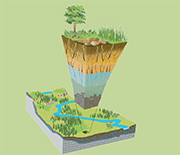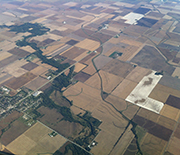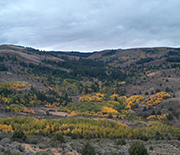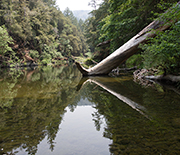News Release 18-108
NSF-supported scientists present new research results on Earth's critical zone at 2018 AGU fall meeting
Topics include remote sensing of seasonal snow, forest ecohydrology in a changing climate, plant stress in drought-prone forests
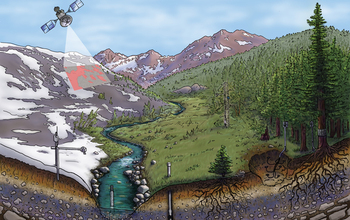
Scientists at NSF's CZOs will present new results at the 2018 AGU meeting.
November 28, 2018
This material is available primarily for archival purposes. Telephone numbers or other contact information may be out of date; please see current contact information at media contacts.
Find related stories on NSF's Critical Zone Observatories.
The thin veneer of Earth's surface that stretches from the top of the forest canopy to the base of bedrock is called the critical zone. It's where fresh water flows, rock turns to soil and life flourishes.
To develop a deeper understanding of the critical zone, the National Science Foundation (NSF) supports nine Critical Zone Observatories (CZOs) across the U.S. NSF CZO scientists study how the critical zone responds to changes in climate and land use.
At the 2018 American Geophysical Union (AGU) fall meeting in Washington, D.C., dozens of CZO researchers will present new findings on Earth's "living skin." The meeting will take place from Dec. 10-14.
CZO scientists will address such subjects as:
- Remote sensing of seasonal snow.
- Forest ecohydrology in a changing climate.
- Indicators of plant water availability and stress in drought-prone forests.
- Aquatic ecosystem responses to human disturbances and management, comparing inland and coastal ecosystems.
- Modeling the why, where and when of regional forest declines.
- The role of microbes in biogeochemical cycles.
These researchers are working to answer questions such as how landscapes evolve over human timescales and over millennia, and how that process is affected by the presence and flow of water. They’re also studying how biological processes affect physical processes such as erosion and weathering, and whether signals in the landscape can reveal information about climate -- how landscapes responded to past climate change and might respond to climate change in the future.
The NSF CZOs will host a Town Hall meeting -- "Critical Zone Observatories: Platforms for Collaborative Science" -- on Thursday, Dec. 13, from 12:30-1:30 p.m. at the Marriott Marquis in Marquis A-C.
For more information, please see the list of AGU CZO science and related sessions, talks and posters.
-NSF-
-
The top of the forest canopy to the base of bedrock is known as Earth's critical zone.
Credit and Larger Version -
Science in the snow: Downloading data on trees and snowmelt at the Southern Sierra CZO.
Credit and Larger Version -
Scientists at the NSF Intensively Managed Landscapes CZO in the Midwest often work with farmers.
Credit and Larger Version -
Carbon in soil is a focus at the NSF Reynolds Creek CZO in Southwest Idaho.
Credit and Larger Version -
At the NSF Eel River CZO, researchers study a watershed that's important to spawning salmon.
Credit and Larger Version
Media Contacts
Cheryl Dybas, NSF, (703) 292-7734, email: cdybas@nsf.gov
The U.S. National Science Foundation propels the nation forward by advancing fundamental research in all fields of science and engineering. NSF supports research and people by providing facilities, instruments and funding to support their ingenuity and sustain the U.S. as a global leader in research and innovation. With a fiscal year 2023 budget of $9.5 billion, NSF funds reach all 50 states through grants to nearly 2,000 colleges, universities and institutions. Each year, NSF receives more than 40,000 competitive proposals and makes about 11,000 new awards. Those awards include support for cooperative research with industry, Arctic and Antarctic research and operations, and U.S. participation in international scientific efforts.
Connect with us online
NSF website: nsf.gov
NSF News: nsf.gov/news
For News Media: nsf.gov/news/newsroom
Statistics: nsf.gov/statistics/
Awards database: nsf.gov/awardsearch/
Follow us on social
Twitter: twitter.com/NSF
Facebook: facebook.com/US.NSF
Instagram: instagram.com/nsfgov



